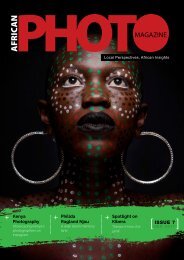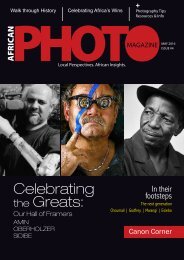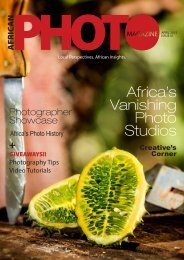African Photo Magazine Issue #6
This is the 6th issue of the Pan-African photography magazine, African Photo Magazine and the main showcase is Ghana Photography. Additionally, we showcase African photographers and visual artists showcased by Performa, Red Hook Labs and Nataal in 2017, in New York City.
This is the 6th issue of the Pan-African photography magazine, African Photo Magazine and the main showcase is Ghana Photography. Additionally, we showcase African photographers and visual artists showcased by Performa, Red Hook Labs and Nataal in 2017, in New York City.
You also want an ePaper? Increase the reach of your titles
YUMPU automatically turns print PDFs into web optimized ePapers that Google loves.
trans-Saharan trade in gold and salt<br />
allowing for larger urban centres to<br />
develop. It furthermore encouraged<br />
territorial expansion to gain control<br />
over the different trade-routes.<br />
Between the 9th and 11th centuries,<br />
the kingdom of Ghana was so rich<br />
that its dogs wore golden collars, and<br />
its horses, which were adorned with<br />
silken rope halters, slept on plush carpets.<br />
Based on animal luxuries alone,<br />
it is no wonder that foreigners touted<br />
Ghana’s kings as the richest men in<br />
the world, and they began greedily<br />
calling the land, the Gold Coast.<br />
Recorded history shows that in 1471,<br />
the Portuguese were the first Europeans<br />
who actively sought to settle in<br />
the coastal regions of West Africa in<br />
order to promote trading. In 1482 they<br />
built a castle at ‘El mina’ (the mine),<br />
near the beach of the present town<br />
Elmina. The Danes were among the<br />
last Europeans to arrive in Ghana in<br />
1650. They built one of the most imposing<br />
castles in Africa in 1661. They<br />
called the castle, Christianborg but<br />
it is now popularly called the Osu<br />
Castle, which currently contains the<br />
President’s main offices.<br />
Beyond this point is the sad tale of<br />
trade where the products were human<br />
beings. The vast continent of<br />
America was short of labourers for<br />
their cotton and cane farms. Where<br />
initially the Portuguese had arrived in<br />
the Gold Coast for the sole purpose<br />
of trade in goods, it became clear that<br />
trading slaves, in human beings, was<br />
much more profitable.<br />
So for over 300 years the Portuguese,<br />
British, French, Swedish and the Germans<br />
saw the Gold Coast and the<br />
neighbouring <strong>African</strong> countries as<br />
bounty fields. In addition to the gold<br />
and mineral resources which were<br />
shipped, were human beings chained<br />
and packed like sardines for the long<br />
and torturous journeys to the Americas.<br />
By the 1870s all European countries<br />
but Britain had left the Gold Coast<br />
after some bargaining arrangements<br />
with Britain. Most of the Gold Coast<br />
was still under the control of native<br />
chiefs. The one area offering the stiffest<br />
resistance, was the Ashanti region.<br />
But in 1874, Britain declared the Gold<br />
Coast as a crown colony even though<br />
there were still vast areas opposing<br />
their occupation. In the same year,<br />
however, Britain with the help of the<br />
southern part of the country attacked<br />
and took over the stronghold (Kumasi)<br />
of the Ashanti tribe.<br />
Accra became the capital of Gold<br />
Coast in 1877 and between 1884-85,<br />
with the scramble for Africa, the Berlin<br />
Conference resulted in most of<br />
Ghana, as we know it now, becoming<br />
a British colony.<br />
When the Gold Coast in 1957 became<br />
the first country in sub-Saharan Africa<br />
to regain its independence from colonial<br />
rule it was renamed in honor of<br />
the long gone empire from which this<br />
great nation was birthed.<br />
Sources:<br />
Wikipedia<br />
Ghana Mumtie<br />
US History.Org<br />
8. The origin of Kente cloth is<br />
explained partly with an intriguing<br />
legend. A man name Otaa Kraban<br />
and his friend Kraku Amoagya from<br />
Bonwire learnt the art of weaving by<br />
observing a spider weaving its web<br />
in the year 1650. Taking the cue from<br />
the spider’s web they wove a strip<br />
of raffia fabric and later improved<br />
upon the skills. They reported their<br />
discovery to their chief who in turn<br />
reported to the Asantehene. The<br />
Asantehene adopted the royal arts<br />
as precious and prestige cloth, and<br />
became the custodian of Asante<br />
Kente.<br />
9. Medicine Man- Gold Coast, West<br />
Africa. (1899)<br />
10. King Mate Kole of East Krobo.<br />
Gold Coast Ghana. July 1892 ©<br />
Basel Mission<br />
11. Fanti women from Sekondi, 1900<br />
© Basel Mission<br />
12. King Prempe after his<br />
reinstatement, Kumase, Ghana,<br />
January 1926 © Basel Mission<br />
13. The War of the Golden Stool,<br />
also known as the Yaa Asantewaa<br />
War, the Third Ashanti Expedition,<br />
the Ashanti Uprising, or variations<br />
thereof, was the final war in a series<br />
of conflicts between the British<br />
Imperial government of the Gold<br />
Coast (later Ghana) and the Empire<br />
of Ashanti, a powerful, semi-autonomous<br />
<strong>African</strong> state that fractiously<br />
co-existed with the British and its<br />
vassal coastal tribes.<br />
When the Ashanti began rebelling<br />
against British rule, the British<br />
attempted to put down the unrest<br />
and demanded that the Asante turn<br />
over to the British the Golden Stool,<br />
the throne and a symbol of Asante<br />
sovereignty. The war ended with<br />
the Ashanti maintaining its de facto<br />
independence. Even though the<br />
Ashanti were annexed into the British<br />
Empire, they ruled themselves<br />
with little reference to the colonial<br />
power. However, when the British<br />
colony of the Gold Coast became<br />
the first independent, sub-Saharan<br />
<strong>African</strong> country in 1957, Ashanti was<br />
subsumed into the newly created<br />
Ghana.<br />
14. Ashanti warriors.<br />
15. March 6th Ghana 1957<br />
commemorates independence<br />
from Great Britain, celebrating the<br />
end of colonial rule and the dawn<br />
of their independence. The photo<br />
is that of Kwame Nkrumah, the first<br />
Prime Minister of the state. Ghana<br />
was the first <strong>African</strong> nation to throw<br />
off the terrible yolk of colonialism.<br />
10<br />
11<br />
08<br />
09<br />
12<br />
13<br />
14 15<br />
28 africanphotomagazine ISSUE 6 JUNE 2017 29










